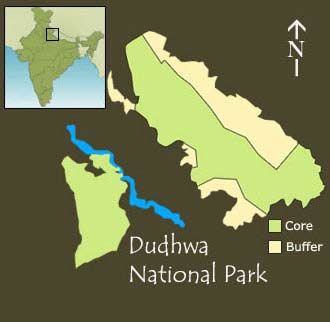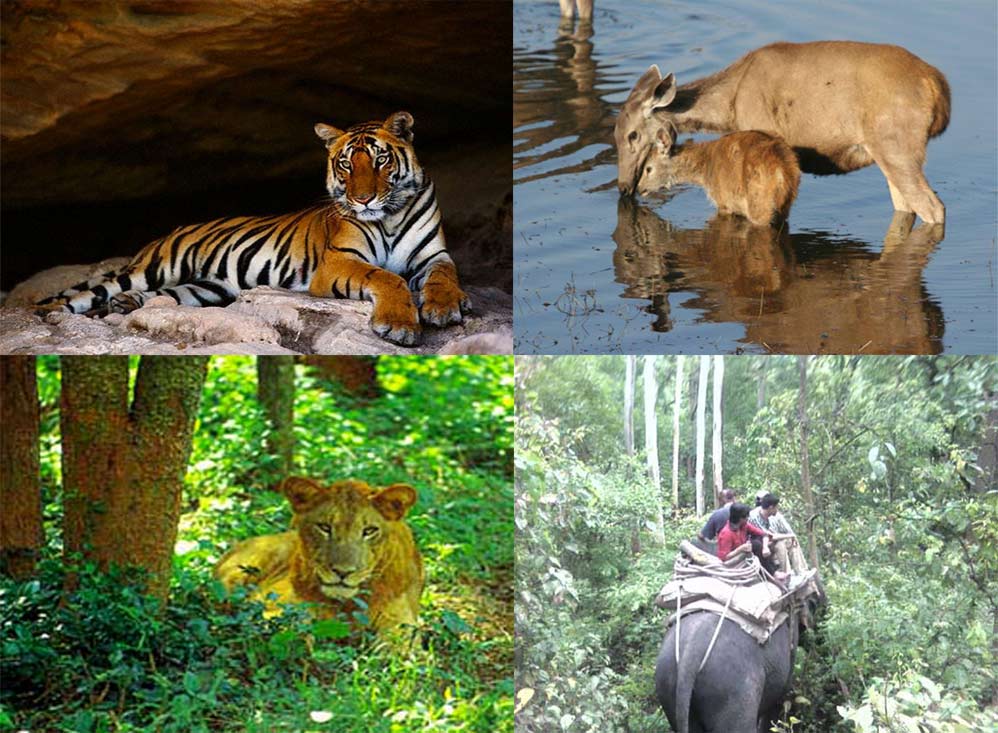Home ::Indian National Parks ::Dudhwa National Park
khimpur Kheri District, and has buffer of reserved forest areas on the northern and southern sides. It represents one of the few remaining examples of a highly diverse and productive Terai ecosystem, supporting a large number of endangered species, obligate species of tall wet grasslands and species of restricted distribution.
The area was established in 1958 as a wildlife sanctuary for Swamp deer. Thanks to the efforts of 'Billy' Arjan Singh the area was notified as a national park in January 1977. In 1987, the park was declared a Tiger Reserve and brought under the purview of the 'Project Tiger'. Together with the Kishanpur Wildlife Sanctuary and the Katarniaghat Wildlife Sanctuary it forms the Dudhwa Tiger Reserve.

Like most of northern India, Dudhwa has an extreme Humid Subtropical with dry winter (CWa) type of climate. Summers are hot with temperatures rising up to 40 °C (104 °F). During winters from mid-October to mid-March, temperatures hover between 20–30 °C (68–86 °F). The months of February to April are ideal for visiting the park.
Prevalent winds are westerly. The hot wind Loo blows strongly from mid-April up to end of May. Monsoon starting in mid-June and lasting up to September accounts for 90% of the annual rainfall of 150 cm (59 in). Temperatures range from between a minimum of9 °C (48 °F) in winter to a maximum of up to45 °C (113 °F) in peak summer.

The area of the park falls within the Upper Gangetic plains and is a vast alluvial plain ranging in altitude from 150 m (490 ft) in the farthest southeast to 182 metres (597 ft) in the extreme north. The park's mosaic of high forest interspersed with grasslands is characteristic of the Terai ecosystems in India and the area is, probably, the last prominent remnant of this type of ecosystem. The forests, especially the sal forests, have always been very dense and can be categorized into Northern tropical semi-evergreen forest, Northern Indian moist deciduous forest, tropical seasonal swamp forest and Northern tropical dry deciduous forest. The main flora comprises sal, asna, shisham, jamun, gular, sehore and bahera. The grasslands comprise about 19% of the park. The wetlands constitute the third major habitat type and include the rivers, streams, lakes and marshes. While many of the major wetlands are perennial with some amount of surface moisture retained round the year, some dry up during hot summer.
The park is home to one of the finest forests in India, some of these trees are more than 150 years old and over 70 ft (21 m) tall.
Major attractions of Dudhwa National Park are the Tigers (population 98 in 1995) and Swamp Deer (population over 1,600). 'Billy' Arjan Singh successfully hand-reared and reintroduced zoo-born tigers and leopards into the wilds of Dudhwa. Some rare species inhabit the park. Hispid Hare, earlier thought to have become extinct, was rediscovered here in 1984.
In the mid 1980s, Indian Rhinoceros was reintroduced into Dudhwa from Assam and Nepal.
The other animals to be seen here include Swamp Deer, Sambar Deer, Barking Deer, Spotted Deer, Hog Deer, Tiger, Indian Rhinoceros, Sloth Bear, Ratel, Jackal, Civet, Jungle Cat, Fishing Cat, Leopard Cat.
The park has a rich bird life, with over 350 species, including the Swamp Francolin, Great Slaty Woodpecker and Bengal Florican. Dudhwa also boasts a range of migratory birds that settle here during winters. It includes among others, painted storks, black and white necked storks, Sarus Cranes, woodpeckers, barbets, kingfishers, minivets, bee-eaters, bulbuls and varied night birds of prey. Dudhwa National Park is a stronghold of the barasingha. Around half of the world's barasinghas are present in Dudhwa National Park.[citation needed] Smaller than the sambar, the barasinghas have 12 antlers that collectively measure up to 100 cm (39 in). One can spot herd of these rare animals passing through open grasslands. Around half of the surviving population of Barasinghas is found in the park. These animals are smaller than sambar and weigh around 180 kg. Due to their slightly woolly, dark brown to pale yellow cloak, the grasslands acts as the perfect camouflage.
En route to Dudhwa, the unique Frog Temple at Oyal can also be visited. The only one of its kind in India, it was built by the former Maharajas of the Oyal estate in the district of Lakhimpur-Kheri. Dedicated to Lord Shiva, the base of the stone temple is built in the shape of a large frog. The temple is at a distance of 10 km from Hargaon on the route to Lakhimpur-Kheri and Dudhwa. Built in the Indo-Saracenic style by the rulers of the Singhai estate, Surat Bhawan Palace is one of the famous palaces of the Terai area. Not far from the Dudhwa Tiger Reserve on the Lakhimpur-Nighasan-Dudhwa route, the palace is set in a large green, 9-acre (36,000 m2) retreat. Expanses of lush lawns, fountains, a swimming pool and interesting architectural details make a visit to the palace worthwhile.
The 19th century Indo-Sarasenic style built Surat Bhawan Palace is located around 8 km from the Dudhwa National Park. One can see the Himalayan Peaks from the Palace terrace on a clear day. The spotting of animals and birds in their natural habitation during Elephant Rides, sitting on top of an Indian elephant is an experience to treasure for a long time.
Travel Information
Drive from Delhi (8–9 hours) or take the train to Shahjehanpur and drive to Dudhwa (3 hours). Alternatively one can fly to Lucknow and drive to Dudhwa 245 km (152 mi) in 6 hours.
Nearest Railway Stations: Dudwa (4 km.), Palia (10 km.), Mailani (37 km.) Nearest Airports: Lucknow, Dhangarhi (Nepal, 35 km.)
The park usually opens in November, after the departure of monsoons (rainy season).
Contact: Director, Dudhwa National Park, Lakhimpur Kheri, Phone: (05872) 52106
Dudhwa National Park Visitors Entrance and service Center is at:28°29′25″N 80°38′47″E.



